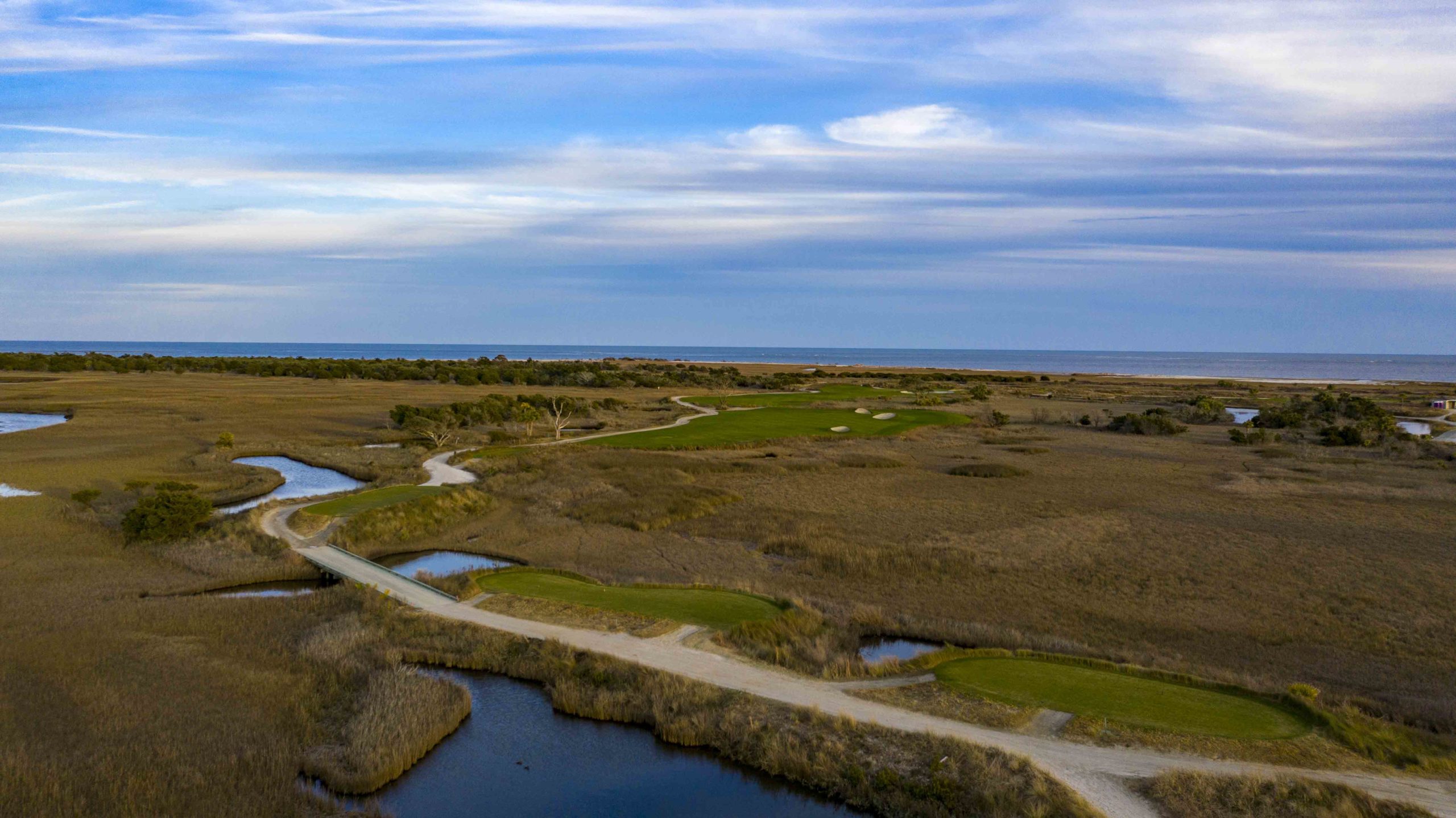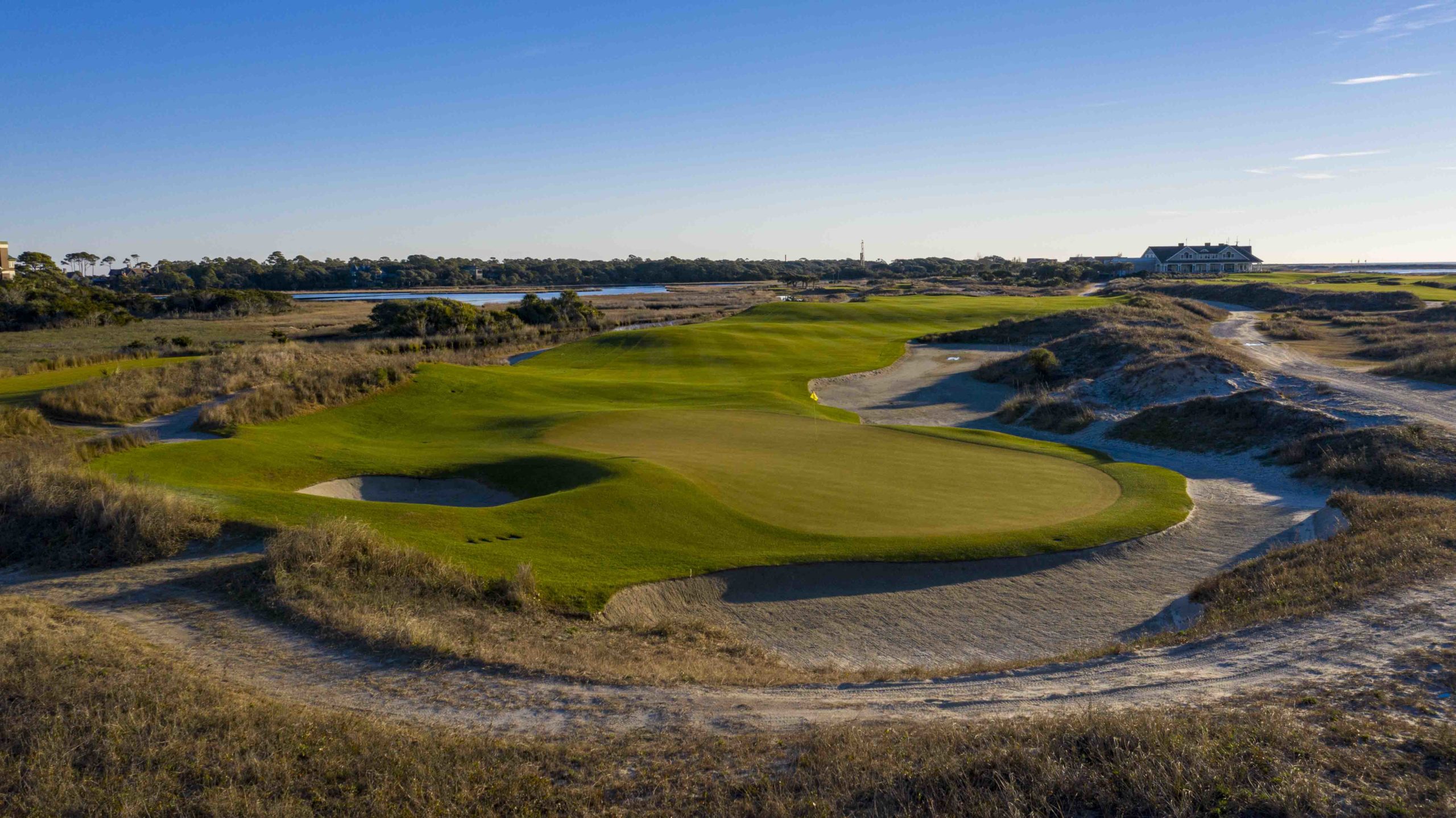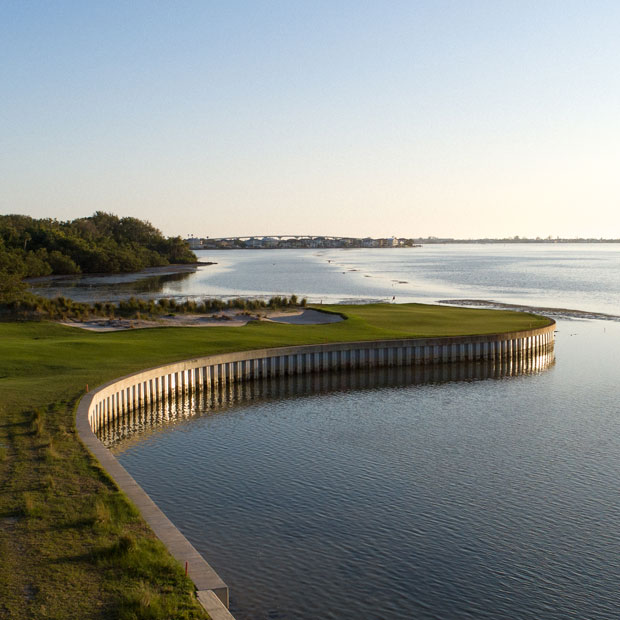One Thing About Every Hole at the Ocean Course
A concise tour of the 2021 PGA Championship venue


Architect Pete Dye was known for his attention to detail, and there are many examples of his fine-grained creativity at the Ocean Course at Kiawah Island. But the 2021 PGA Championship is almost here, so rather than overwhelm you with minutiae, I figured I’d give you one thing to watch for on every hole.
Hole 1 – par 4 – 396 yards
A gentle handshake, the opener at the Ocean Course was the third easiest hole in at the 2012 PGA Championship. One tricky aspect of the 1st, however, is its distance from the driving range. Players will have to take a shuttle out to the tee, which could throw a wrench in some warm-up routines.

The 1st hole at the Ocean Course. Photo: Andy Johnson
Hole 2 – par 5 – 557 yards
This par 5 demands a great tee shot, as those who don’t hit the fairway may have to lay up on their second. A marshy waterway crosses the fairway well short of the green, and if you don’t get past it, you’ll have a lengthy approach.

The 2nd hole at the Ocean Course. Photo: Andy Johnson
Hole 3 – par 4 – 390 yards
The 3rd should play into the wind early in the week, likely resulting in layups off the tee. The safe landing zone, however, is on an upslope, making the wedge approach to this repelling green especially difficult.

The 3rd hole at the Ocean Course. Photo: Andy Johnson
Hole 4 – par 4 – 484 yards
The new 4th tee has reoriented the angles of this par 4. The saltwater-marsh hazard now runs on a diagonal, and the bunkers are directly in play on the right. This is one of the more exacting tee shots on the Ocean Course, which is saying something.

The 4th hole at the Ocean Course. Photo: Andy Johnson
Hole 5 – par 3 – 207 yards
This is where the routing of the front nine turns, so players will face a new wind on the par-3 5th hole. It will be instructive to see which players can judge the elements correctly the first time.

The 5th hole at the Ocean Course. Photo: Andy Johnson
Hole 6 – par 4 – 490 yards
The contours at the back of the 6th green divide the putting surface into a bunch of small sections, including a repelling ridge, a bowl next to the bunker on the left, and a fallaway back portion.

The 6th hole at the Ocean Course. Photo: Andy Johnson
Hole 7 – par 5 – 579 yards
Playing downwind early in the week, the 7th will be the most gettable of the par 5s at the Ocean Course. The drive is tricky, though: long hitters will need to squeeze their tee shots into the bend of the fairway, where waste areas encroach on both sides.

The 7th hole at the Ocean Course. Photo: Andy Johnson
Hole 8 – par 3 – 198 yards
My favorite par 3 at Kiawah will repel tee balls in all directions and play uncomfortably downwind early in the week. This shot will require real touch.

The 8th hole at the Ocean Course. Photo: Andy Johnson
Hole 9 – par 4 – 514 yards
The green at the long par-4 9th has many notable features, my favorite of which are the two big ramps on the back-right edge. These can help players funnel long-iron approaches toward pins, but if you miss long, you’ll be in a scary, scary spot.

The 9th hole at the Ocean Course. Photo: Andy Johnson
Hole 10 – par 4 447 yards
This green is shallow and unreceptive to downwind shots out of the rough, so there will be a particular premium on finding the 10th fairway, even by Kiawah’s standards.

The 10th hole at the Ocean Course. Photo: Andy Johnson
Hole 11 – par 5 – 593 yards
If you go for it on this par 5, you have to be perfect. Missing left by a foot sends you tumbling down a slope into native grasses, and missing right means bunkers, more native grasses, or water.

The 11th hole at the Ocean Course. Photo: Andy Johnson
Hole 12 – par 4 – 484 yards
The best angle to approach this green is now in the left rough thanks to the PGA’s narrowing of the fairway. It’s dumb. Nonetheless, expect players to hit a lot of shots from over here.

The 12th hole (left) at the Ocean Course. Photo: Andy Johnson
Hole 13 – par 4 – 497 yards
I consider this the most exacting tee shot on the Ocean Course. The canal angles in along the right side exactly where a good player might miss it, and the bunkers on the left aren’t very desirable, either. You just have to step up and hit a great drive. I’ll be interested to see if any players choose to lay up short of the creek.

The 13th hole at the Ocean Course. Photo: Andy Johnson
Hole 14 – par 3 – 238 yards
One of the most entertaining sights in golf is a rolling ball, and that’s what the 14th is designed to produce. The back half of the green should function like a Redan, meaning that players will have to feed their tee shots from short right to back left in order to get close to back pins.

The 14th hole at the Ocean Course. Photo: Andy Johnson
Hole 15 – par 4 – 466 yards
The tiny 15th green tiny resembles one of Perry Maxwell’s famed potato-chip designs, and it’s beautifully situated between the dunes on the right and the sandy expanses and scrub on the left.

The 15th hole at the Ocean Course. Photo: Andy Johnson
Hole 16 – par 5 – 608 yards
If this monster plays into the wind on Thursday and Friday, even the longest players will have to hit three good shots to get there. That’s one of the rarest things you can say about a golf hole in a pro tournament. Making the second shot particularly frightening is the giant waste area intruding on the right side.

The 16th hole at the Ocean Course. Photo: Andy Johnson
Hole 17 – par 3 – 223 yards
If you have any memory or awareness of the 1991 Ryder Cup, you know all about the 17th hole’s excruciating difficulty. It hasn’t gotten any easier. A genuine hit-it-or-else proposition.

The 17th hole at the Ocean Course. Photo: Andy Johnson
Hole 18 – par 4 – 505 yards
The new 18th tee installed by Scot Sherman is working wonders. Instead of the short irons we saw in 2012, there should be plenty of fairway-wood approaches when the wind is against the players early in the week.

The 18th hole at the Ocean Course. Photo: Andy Johnson
Leave a comment or start a discussion
Engage in our content with thousands of other Fried Egg Golf Club Members
Engage in our content with thousands of other Fried Egg Golf Members
Get full access to exclusive benefits from Fried Egg Golf
- Member-only content
- Community discussions forums
- Member-only experiences and early access to events











Leave a comment or start a discussion
Lorem ipsum dolor sit amet, consectetur adipiscing elit. Suspendisse varius enim in eros elementum tristique. Duis cursus, mi quis viverra ornare, eros dolor interdum nulla, ut commodo diam libero vitae erat. Aenean faucibus nibh et justo cursus id rutrum lorem imperdiet. Nunc ut sem vitae risus tristique posuere. uis cursus, mi quis viverra ornare, eros dolor interdum nulla, ut commodo diam libero vitae erat. Aenean faucibus nibh et justo cursus id rutrum lorem imperdiet. Nunc ut sem vitae risus tristique posuere.